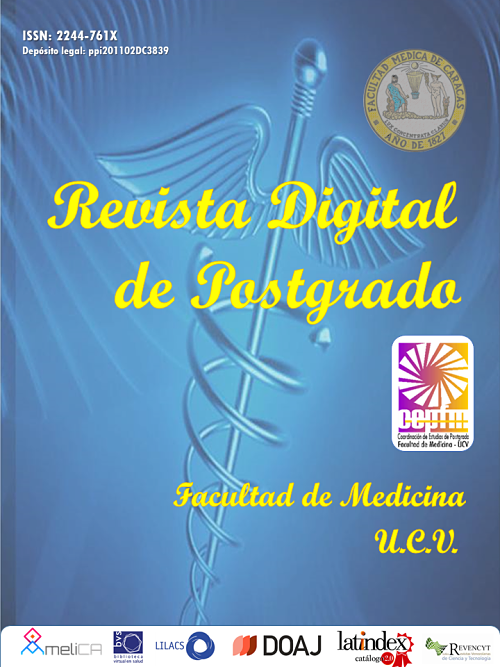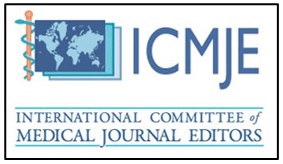Listeria monocytogenes y mecanismo de caballo de Troya a través de la barrera hematoencefálica
DOI:
https://doi.org/10.37910/RDP.2024.13.1.e389Palabras clave:
Listeria monocytogenes, Monocitos, Macrófagos, Quimiotaxis, Barrera HematoencefálicaResumen
Las infecciones del sistema nervioso central son potencialmente mortales, causadas por patógenos, como bacterias, virus y hongos. Para llegar hasta el
cerebro, los microorganismos utilizan diversas vías y formas. Este patogeno es una bacteria grampositiva corta, flagelar e intracelular, con la capacidad de inducir su internalización en células fagocíticas (monocitos/macrófagos) y no fagocíticas (células endoteliales). Al infectar los macrófagos, estos microorganismos se valen de su capacidad de fijación, adhesión y migración transendotelial, para cruzar la barrera hematoencefálica, finalmente, generando meningitis bacteriana. En esta revisión describimos el mecanismo de caballo de Troya usado por Listeria monocytogenes para invadir el cerebro en el desarrollo deenfermedades infecciosas e incorporamos nuevos conocimientos sobre moléculas que intervienen en dicho mecanismo.
Descargas
Citas
Le Govic Y, Demey B, Cassereau J, Bahn YS, Papon N. Pathogens infecting the central nervous system.PLoS Pathog. 2022; 18(2): e1010234.
Subbarao S, Ribeiro S, Campbell H, Okike I, Ramsay ME, Ladhani SN. Trends in laboratory-confirmed bacterial meningitis (2012-2019): national observational study, England. Lancet Reg Health Eur. 2023; 32:100692.
Koelman DLH, van Kassel MN, Bijlsma MW, Brouwer MC, van de Beek D, van der Ende A. Changing Epidemiology of Bacterial Meningitis Since Introduction of Conjugate Vaccines: 3 Decades of National Meningitis Surveillance in The Netherlands. Clin Infect Dis. 2021; 73(5): e1099- e1107.
Hasbun R. Progress and Challenges in Bacterial Meningitis: A Review. JAMA. 2022; 328(21): 2147-2154.5. Costa BKD, Sato DK. Viral encephalitis: a practical review on diagnostic approach and treatment. J Pediatr (Rio J). 2020; 96(Suppl 1): 12-19.
Santiago FH, Onken MD, Cooper JA, Klein RS, Doering TL. Trojan Horse Transit Contributes to Blood- Brain Barrier Crossing of a Eukaryotic Pathogen. mBio. 2017; 8(1): e02183-16.
Echezuría L, León R, Rodríguez E, Rísquez A. Epidemiología de la meningitis en Venezuela 2010. Archivos Venezolanos de Puericultura y Pediatría. 2010; 73(4): 29-36.
Li Z, Bruno VM, Kim KS. Central Nervous System-Infecting Pathogens Escherichia coli and Cryptococcus neoformans Exploit the Host Pdlim2 for Intracellular Traversal and Exocytosis in the Blood-Brain Barrier. Infect Immun. 2021; 89(10): e0012821.
Julian J, Robiatul A, Sri W. Biomolecular activity of Cryptococcus during Cryoticiccisus: A review of molecular intereactions of Cryptococcus with human immune system and Blod-Brain-Barriet. Afr J Infect Dis. 2023; 18(1):11-22.
Kaya M, Ahishali B. Basic physiology of the blood-brain barrier in health and disease: a brief overview. Tissue Barriers. 2021; 9(1):1840913.
Wu D, Chen Q, Chen X, Han F, Chen Z, Wang Y. The blood-brain barrier: structure, regulation, and drug delivery. Signal Transduct Target Ther. 2023; 8(1): 217.
Kadry H, Noorani B, Cucullo L. A blood-brain barrier overview on structure, function, impairment, and biomarkers of integrity. Fluids Barriers CNS. 2020; 17(1): 69.
Zhao Y, Gan L, Ren L, Lin Y, Ma C, Lin X. Factors influencing the blood-brain barrier permeability. Brain Res. 2022; 1788: 147937.
Marchetti L, Engelhardt B. Immune cell trafficking across the blood-brain barrier in the absence and presence of neuroinflammation. Vasc Biol. 2020; 2(1): H1-H18.
Kim KS. Mechanisms of microbial traversal of the blood-brain barrier. Nat Rev Microbiol. 2008; 6(8): 625-634.
Shahid AD, Lu Y, Iqbal MA, Lin L, Huang S, Jiang X, Chen S. Listeria monocytogenes crosses blood brain barrier through Rho GTPases induced migration of macrophages and inflammatory interleukin expression. Microb Pathog. 2021; 159: 105143.
Sibanda T, Buys EM. Listeria monocytogenes Pathogenesis: The Role of Stress Adaptation. Microorganisms. 2022; 10(8): 1522.
Eitel J, Suttorp N, Opitz B. Innate immune recognition and inflammasome activation in listeria monocytogenes infection. Front Microbiol. 2011; 1: 149.
Shen Y, Naujokas M, Park M, Ireton K. InIB-dependent internalization of Listeria is mediated by the Met receptor tyrosine kinase. Cell. 2000; 103(3): 501-510.
Galea I. The blood-brain barrier in systemic infection and inflammation. Cell Mol Immunol. 2021; (11): 2489-2501.
Ivan DC, Walthert S, Locatelli G. Monocyte recruitment to the inflamed central nervous system: migration pathways and distinct functional polarization. BioRxiv. (2020): 2020-04.
Denes A, Hansen CE, Oezorhan U, Figuerola S, de Vries HE, Sorokin L, et al. Endothelial cells and macrophages as allies in the healthy and diseased brain. Acta Neuropathol. 2024; 147(1): 38.
Qiu YM, Zhang CL, Chen AQ, Wang HL, Zhou YF, Li YN, Hu B. Immune Cells in the BBB Disruption After Acute Ischemic Stroke: Targets for Immune Therapy? Front Immunol. 2021; 12: 678744
Descargas
Publicado
Cómo citar
Número
Sección
Licencia
Derechos de autor 2024 Ramón Andrade Pineda, Andrés Duque Prieto

Esta obra está bajo una licencia internacional Creative Commons Atribución 4.0.
Usted es libre de:
- Compartir — copiar y redistribuir el material en cualquier medio o formato
- Adaptar — remezclar, transformar y construir a partir del material
- para cualquier propósito, incluso comercialmente.
Bajo los siguientes términos:
-
Atribución — Usted debe dar crédito de manera adecuada, brindar un enlace a la licencia, e indicar si se han realizado cambios. Puede hacerlo en cualquier forma razonable, pero no de forma tal que sugiera que usted o su uso tienen el apoyo de la licenciante.
- No hay restricciones adicionales — No puede aplicar términos legales ni medidas tecnológicas que restrinjan legalmente a otras a hacer cualquier uso permitido por la licencia.












